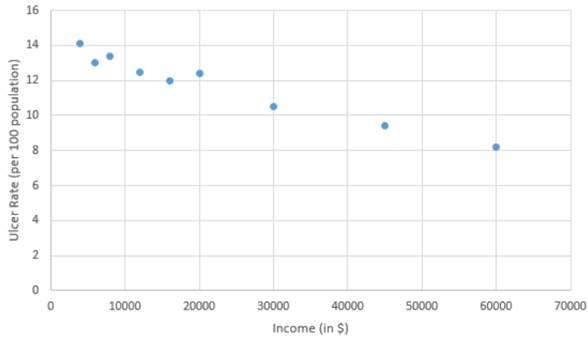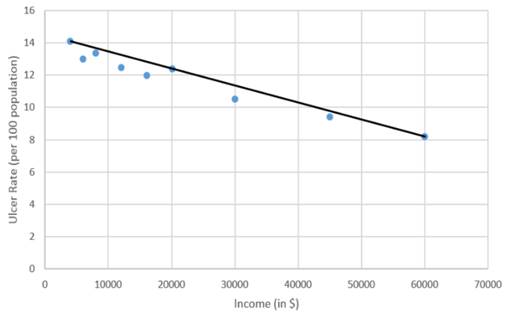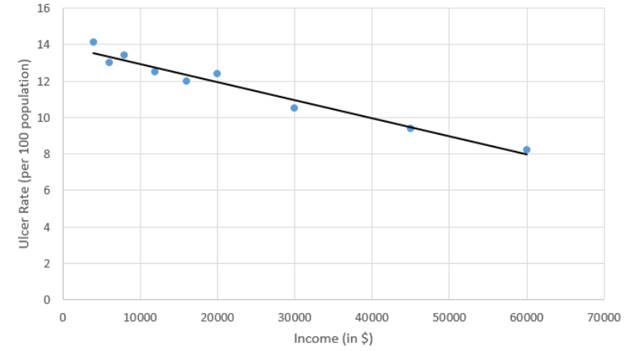
Concept explainers
a.
To make: a
a.
Answer to Problem 21E
The scatter plot of the data is shown below.
Explanation of Solution
Given:
The given table shows peptic rules ulcer rates for various rates:
| Income | Ulcer rate(per 100 population) |
Calculation:
The scatter plot of the data is shown below:

b.
To find: a linear model using the first and last data points and graph the linear model.
b.
Answer to Problem 21E
Explanation of Solution
Given:
The given table shows peptic rules ulcer rates for various rates:
| Income | Ulcer rate(per 100 population) |
Calculation:
According to the table, the first point is
The slope of the linear equation is given by
So,
Now, use the given point slope form to write the equation of the line. It is to choose any of the two points to use. Point-slope form of the equation is given by
Now, if it choose the first point, it get
In order to solve for y , it must first distribute
The graph of the linear model is shown below:

Hence, a linear model using the first and last data points is
c.
To find: the least squares regression line and graph the regression line.
c.
Answer to Problem 21E
Explanation of Solution
Given:
The given table shows peptic rules ulcer rates for various rates:
| Income | Ulcer rate(per 100 population) |
Calculation:
To find the linear regression, use the
Step 1: Hit STAT and then press enter when Edit is highlighted.
Step 2: Enter the x-coordinate under the
Step 3: Hit STAT, use the arrow key to scroll right to CALC and the scroll down to
Step 4: Press Enter multiples time until the program runs. If X list does not show
Step 5: The program will output values for a and b .
The program outputs the values of
Hence, the least squares regression line
So, the least squares regression line is shown below:

d.
To estimate: the ulcer rate for an income of
d.
Answer to Problem 21E
Explanation of Solution
Given:
From part (c)
Calculation:
It is known from part (c), the equation of the linear model according to Least Squares Regression Line approach:
When the income rate is
Hence, the ulcer rate for an income of
e.
To check: how likely is someone with an income of
e.
Answer to Problem 21E
Explanation of Solution
Given:
The given model is
Calculation:
In this case
There is a chance of approximately
f.
To check: that it is reasonable to apply the model to someone with an income of
f.
Answer to Problem 21E
It is not reasonable.
Explanation of Solution
Given:
The given model is
Calculation:
It will be not reasonable to apply the linear model to someone with an income of
Besides, apply the equation, it is finding a negative ulcer rate which is an irrational number
Chapter 1 Solutions
Single Variable Calculus: Concepts and Contexts, Enhanced Edition
 Calculus: Early TranscendentalsCalculusISBN:9781285741550Author:James StewartPublisher:Cengage Learning
Calculus: Early TranscendentalsCalculusISBN:9781285741550Author:James StewartPublisher:Cengage Learning Thomas' Calculus (14th Edition)CalculusISBN:9780134438986Author:Joel R. Hass, Christopher E. Heil, Maurice D. WeirPublisher:PEARSON
Thomas' Calculus (14th Edition)CalculusISBN:9780134438986Author:Joel R. Hass, Christopher E. Heil, Maurice D. WeirPublisher:PEARSON Calculus: Early Transcendentals (3rd Edition)CalculusISBN:9780134763644Author:William L. Briggs, Lyle Cochran, Bernard Gillett, Eric SchulzPublisher:PEARSON
Calculus: Early Transcendentals (3rd Edition)CalculusISBN:9780134763644Author:William L. Briggs, Lyle Cochran, Bernard Gillett, Eric SchulzPublisher:PEARSON Calculus: Early TranscendentalsCalculusISBN:9781319050740Author:Jon Rogawski, Colin Adams, Robert FranzosaPublisher:W. H. Freeman
Calculus: Early TranscendentalsCalculusISBN:9781319050740Author:Jon Rogawski, Colin Adams, Robert FranzosaPublisher:W. H. Freeman
 Calculus: Early Transcendental FunctionsCalculusISBN:9781337552516Author:Ron Larson, Bruce H. EdwardsPublisher:Cengage Learning
Calculus: Early Transcendental FunctionsCalculusISBN:9781337552516Author:Ron Larson, Bruce H. EdwardsPublisher:Cengage Learning





